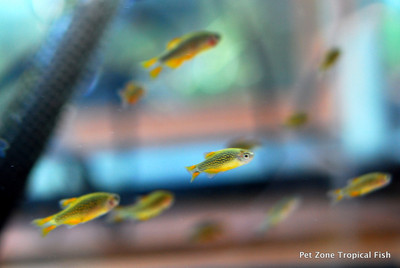Galaxy Rasbora (Celestial Pearl Danio) - Danio margaritatus
Posted by Max Gandara on on 18th Sep 2024
Galaxy Rasbora (Celestial Pearl Danio) - Danio margaritatus
The Galaxy Rasbora, also known as the Celestial Pearl Danio, is a tiny, vividly colored fish that has captured the attention of aquarists worldwide. Despite its name, it is technically a member of the danio family and stands out due to its vibrant coloration and unique pattern. Native to Southeast Asia, these fish are perfect for nano tanks or peaceful community setups, where their beauty can be fully appreciated.
Natural Habitat
The Galaxy Rasbora originates from small ponds and streams in the highlands of Myanmar (Burma), particularly around the Salween River basin. These waters are typically shallow, slow-moving, and densely vegetated, providing plenty of hiding spots and shelter. The natural environment of the Galaxy Rasbora includes soft, slightly acidic water with lots of leaf litter, creating tannin-stained waters that are rich in plant and insect life.
Appearance
One of the most striking features of the Galaxy Rasbora is its dazzling appearance. These fish have a deep blue body adorned with bright, pearly spots, giving them their "galaxy" moniker. The males typically display more vivid colors than the females, with fiery red-orange fins that stand out against their blue bodies. Females, while still beautiful, are generally duller and slightly rounder in shape. Both sexes grow to about 0.8 inches (2 cm) in length, making them perfect for smaller tanks.
Aquarium Care
Galaxy Rasboras are relatively hardy and easy to care for, provided their tank is well-maintained and they are kept in suitable conditions.
- Tank Size: A tank of at least 10 gallons (38 liters) is ideal for a small group of Galaxy Rasboras. Since they are schooling fish, it's best to keep them in groups of six or more to ensure they feel secure and exhibit their natural behaviors.
- Water Parameters: These fish prefer slightly cooler water temperatures, between 68°F and 78°F (20°C - 25°C), with a pH range of 6.5 to 7.5. Soft to moderately hard water is ideal. Regular water changes and good filtration are necessary to keep the tank’s water quality in top condition, as even small fish can be affected by poor water parameters.
- Tank Setup: A well-planted tank with plenty of hiding spots is ideal for Galaxy Rasboras. Dense vegetation, such as Java moss, Anubias, or floating plants, helps replicate their natural habitat and makes them feel safe. Adding some driftwood or leaf litter can create the tannin-rich environment they are used to. They prefer subdued lighting, which can be achieved with floating plants or dimmable tank lights.
- Diet: In the wild, Galaxy Rasboras feed on small invertebrates, so providing a varied diet in captivity is essential for their health. They readily accept high-quality micro-pellets, crushed flakes, and live or frozen foods like daphnia, brine shrimp, and micro-worms. Offering a varied diet will ensure they maintain their bright colors and active behavior.
- Behavior and Tank Mates: Galaxy Rasboras are peaceful, schooling fish that do best in groups. They can be shy at first, but when kept in a proper environment with other peaceful species, they become more confident. Suitable tank mates include other small, peaceful fish like Ember Tetras, Chili Rasboras, or small shrimp species. Avoid housing them with larger or aggressive fish, as their small size makes them vulnerable.
Breeding
Breeding Galaxy Rasboras in captivity is possible and follows typical breeding practices for small schooling fish. They are egg scatterers, and spawning usually takes place in dense plants or spawning mops. Once eggs are laid, it’s advisable to remove the adults to prevent them from eating the eggs. The eggs hatch in about two to three days, and the fry can be fed infusoria or liquid fry food until they are large enough to accept baby brine shrimp or micro-worms.
Common Issues
While Galaxy Rasboras are hardy, they can be sensitive to poor water quality. Regular maintenance, including water changes and monitoring water parameters, is crucial to keeping them healthy. Additionally, they may become stressed or lose their color if housed with incompatible tank mates or kept in too small a group. Providing a peaceful, planted tank and maintaining stable conditions will help them thrive.
Conclusion
The Galaxy Rasbora is a stunning addition to any nano or planted aquarium. Their small size, peaceful nature, and dazzling appearance make them a favorite among aquarists. With the right care, including a well-maintained environment, a varied diet, and suitable tank mates, these fish will flourish and add a touch of brilliance to any aquarium.

